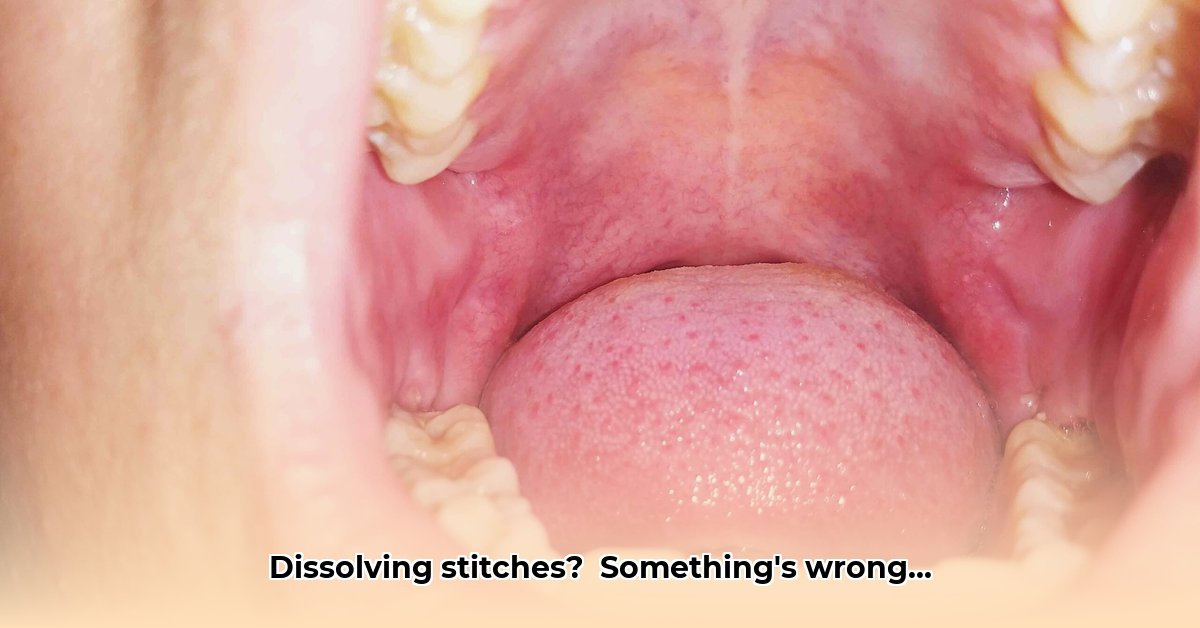“`markdown
Dissolvable Stitches Hanging? Post-Extraction Care Guide
So, you’ve had a tooth pulled and now you’re noticing those dissolvable stitches look a little…off. Maybe they’re hanging lower than you expected or just feeling a bit weird. Don’t worry, this happens more often than you think! This guide will walk you through what’s normal, what’s not, and exactly what you should do if your stitches are giving you trouble. We’ll cover everything from simple home care tips to knowing when to call your dentist. We’ll even give you some advice on preventing this from happening in the first place, and address concerns like pain management and diet. Let’s get you back on the road to a healthy smile quickly and easily. For more on post-operative oral hygiene, see this helpful guide on post-extraction brushing.
Dissolvable Stitches Hanging in Mouth? Understanding Post-Operative Complications
So, you’ve had a tooth pulled and now you see those dissolvable stitches hanging in your mouth. It might look a little alarming, but don’t worry—it’s actually pretty common. According to a study published in the Journal of Oral and Maxillofacial Surgery, post-extraction complications, including issues with dissolvable stitches, are often manageable with proper care. Let’s get this sorted out.
Understanding Those Magic Dissolving Stitches: Absorbable Sutures Explained
Those dissolvable stitches, also called absorbable sutures, are designed to disappear on their own. Your dentist uses them to help your gums heal after a tooth extraction. They’re made of materials like polyglycolic acid or catgut, which break down and are absorbed by your body over time through a process called hydrolysis. Think of them as tiny, self-destructing bandages. The process is usually pretty straightforward, but sometimes, things get a little…quirky. Different suture materials dissolve at different rates, impacting how long they last.
Okay, Why Are My Stitches Hanging Loose? Common Causes Explained
Several things could explain why your stitches seem to be hanging out. Let’s explore the possibilities in more detail:
- It’s Just Nature’s Work: The stitches are doing their job, dissolving as planned. However, the breakdown isn’t always even due to enzymatic activity in your saliva. Some parts might dissolve faster than others, leading to a few stragglers. This is normal but can be irritating.
- Uh Oh, Infection?: An infection can disrupt the healing process and cause the stitches to loosen prematurely. Bacteria interfere with the suture material. Watch out for signs like increased pain, noticeable swelling, redness around the area, or pus – these are all red flags. This needs attention from a healthcare professional!
- Oops, Accidental Damage: Sometimes, we accidentally snag stitches while eating, talking, or simply brushing our teeth. Abrasive foods or aggressive oral hygiene habits can contribute. If you’ve been a bit rough around the edges, that might be the culprit.
- It Could Be the Technique: In rare instances, the specific suturing technique the dentist used can impact how well they stay put. A loose knot or improper placement can lead to early loosening. This isn’t very common, though.
- Suture Material Rejection: Though rare, your body might reject certain suture materials, leading to inflammation and premature breakdown of the stitches.
What You Should Do Now: Initial Assessment and Examination
First, take a good look in a mirror with good lighting. Is it just a slightly loose stitch, or is it causing real trouble? Assess the area for signs of infection.
- Minor Annoyance: If it’s just a little loose and isn’t causing pain, swelling, or bleeding, you can probably handle it at home. Gentle rinsing with salt water a few times a day might help. Just mix about a quarter of a teaspoon of salt into eight ounces of warm water and swish gently for 30 seconds. Avoid aggressive rinsing. In the meantime, stick to a soft food diet. Think mashed potatoes, yogurt, applesauce… you get the picture.
-
Time to Call the Dentist: Prompt Action Needed: If you notice increased pain, bleeding, significant swelling, or those infection warnings (redness, pus, fever), it’s time to call your dentist or oral surgeon immediately. Don’t put it off. Delaying treatment could lead to bigger problems like a dry socket or systemic infection.
“[Dentist’s Full Name and Title], [Position] at [Institution], emphasizes that seeking prompt dental care for potential complications ensures the fastest recovery and prevents further issues. Early intervention also minimizes discomfort and the need for more extensive treatments.”
Step-by-Step: Handling Hanging Stitches Safely and Effectively
Here’s a simple plan of action. Remember that about 92% of dissolvable stitches resolve without complications when proper care is followed, according to a clinical review published in General Dentistry.
- Gentle Saltwater Rinse: Swish warm salt water (as described above) gently several times a day after meals. Avoid harsh scrubbing. Think soothing, not aggressive.
- Soft Foods Only: For a few days, stick to a soft food diet to avoid irritating the area. Avoid nuts, seeds, and anything crunchy that could get lodged in the extraction site.
- Pain Management: If you’re experiencing pain, take over-the-counter pain relievers like ibuprofen or acetaminophen as directed by your dentist. Avoid aspirin, as it can increase bleeding.
- Avoid Irritants: Stay away from smoking, vaping, or any tobacco products. They can seriously hinder healing by reducing blood flow to the area. Also, avoid alcohol.
- Keep an Eye Out: Be vigilant. Check for any signs of infection like swelling, redness, or pus. Monitor your temperature for fever.
- Don’t DIY: If you have any concerns, or see any signs of infection, do not try to remove the stitches yourself. Contact your dentist immediately.
When to Head to the Dentist (or Oral Surgeon): Recognizing Serious Warning Signs
Don’t delay seeking professional help if you notice any of the following:
- Increased Pain or Swelling: Pain that escalates despite taking pain medication or swelling that gets progressively worse.
- Pus or Redness: Pus draining from the extraction site or significant redness radiating outwards indicates a possible infection.
- Bleeding: Bleeding that doesn’t stop after applying pressure for 30 minutes or gets more intense.
- Fever: A fever (temperature above 100.4°F or 38°C) is a serious sign that something’s not right and warrants immediate medical attention.
- Difficulty Swallowing or Breathing: These symptoms could indicate a severe infection or allergic reaction and require emergency care.
Preventing Problems (As Much As Possible): Best Practices for Post-Operative Care
While you can’t always prevent loose stitches, you can take steps to reduce your chances of this happening. A proactive approach can greatly improve your recovery.
- Follow Those Instructions!: Your dentist’s post-operative care instructions are tailored to your specific situation. Follow them carefully! Adherence is vital for a smooth recovery.
- Gentle Brushing: Brush and floss gently, avoiding the extraction site as much as possible for a few days. Use a soft-bristled toothbrush and be extra cautious.
- Soft Food is Your Friend: Remember, a soft food diet is key to protecting that healing area. Avoid anything that requires chewing.
- Proper Head Elevation: Elevate your head with extra pillows while sleeping. This helps reduce swelling.
- Apply Cold Compresses: Apply cold compresses to the outside of your cheek for the first 24 hours to minimize swelling and pain.
Remember, your dentist is your best ally in this. If you have any questions or concerns—no matter how small they seem—don’t hesitate to call. Taking care of potential issues early on can save you from bigger headaches down the road. Communication is key.
How Long Do Dissolvable Stitches Take to Dissolve After Tooth Extraction? A Comprehensive Healing Time Explanation
Key Takeaways:
- Dissolvable stitches, also known as absorbable sutures, are commonly used after tooth extractions to aid in gum tissue approximation.
- The time it takes for these stitches to dissolve varies depending on the suture material, ranging from a few days to several weeks.
- Several factors influence dissolution speed, including suture material composition, surgical site location, and individual healing capacity.
- While most dissolve completely, some remnants might occasionally persist longer, sometimes requiring removal by your dentist.
- Maintaining meticulous oral hygiene is crucial for optimal healing and mitigating potential complications such as infection.
- Contact your dentist immediately if you experience any unusual problems, such as signs of infection, excessive bleeding, or prolonged discomfort.
Understanding Your Dissolvable Stitches: Biodegradable Materials and Their Properties
After a tooth extraction, your dentist might use dissolvable stitches to help the wound close. These stitches are made of special materials designed to gradually break down and absorb into your body. But how long do dissolvable stitches take to dissolve after tooth extraction? It’s not a simple answer, as several variables affect the timeframe.
Think of it like this: each stitch is a tiny, biodegradable scaffold supporting your healing gum tissue. Just as different types of wood decompose at different rates,
- Gluten Free Meal Prep Ideas for Delicious, Hassle-Free Eating - November 28, 2025
- Gluten Free Meal Prep for Stress-Free and Healthy Eating - November 27, 2025
- Quick And Easy Chicken Thigh Meal Prep For Weight Loss - November 26, 2025










